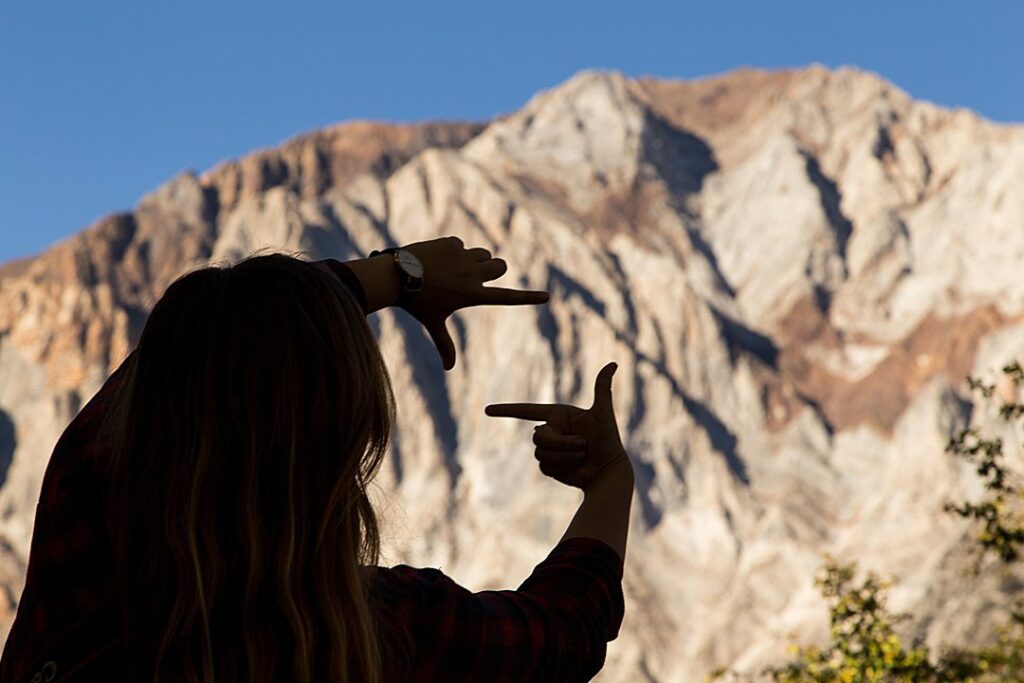The Eastern Sierra, with its dramatic landscapes and ever-shifting moods, stands as one of nature’s grandest canvases. Every turn, every peak, and every valley offers photographers an array of scenes to capture, from the ethereal landscape of Mono Lake to the imposing majesty of Mount Morrison.
Whether you’re chasing the golden hues of fall, the tranquil reflections of spring, or the stark contrasts of winter, the Eastern Sierra promises a bounty for every kind of vista-hunter.
This guide is your curated roadmap to capturing the essence of this region, a place where nature not only poses but performs, making every click of the shutter a story in itself.
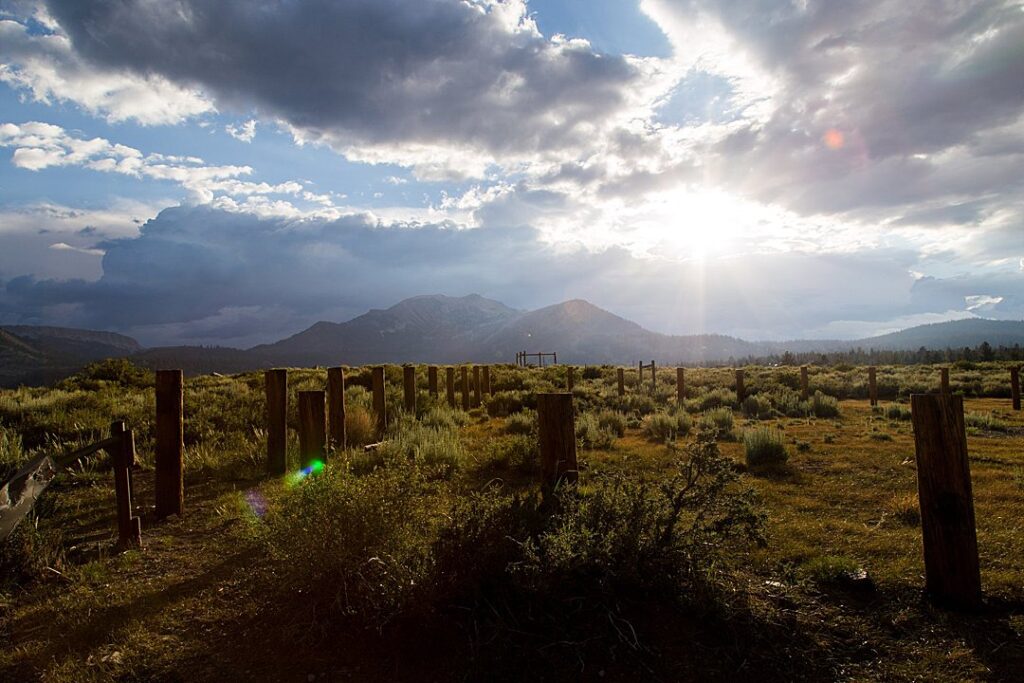
Photo Courtesy: Mammoth Lakes Tourism
Starting at Sierra Meadows Ranch
When you make Sierra Meadows Ranch your hub, you get to enjoy vivid panoramic mountain views right outside your door.
Situated amidst stunning natural beauty, every corner of Sierra Meadows is photo-worthy. Set your camera up to capture the sparkling night sky with little light pollution.
From Morning to Night: The Photographic Charm of Sierra Meadows
The Ranch, with its quaint cabins set against dramatic mountain backdrops, is an ideal setting for landscape photography enthusiasts or those seeking unique travel photos. Set up your shots and showcase your mornings watching the sunrise. Or evenings around the fire pit.
Nature’s Splendor Right Outside Your Door
Whether you’re lucky enough to capture the iconic cloud formation called “Dave’s Wave,” painting the sky above Mammoth Mountain red at sunset, or want a warm and comfortable place to set up a night photo session under crystal-clear skies studded with stars, Sierra Meadows Ranch helps you enjoy a comfortable stay amidst nature’s grandeur.
- Morning Glory: Set out early in the morning to catch golden hour light washing over nearby meadows and forest trails. It’s a tranquil experience highlighting the soft glow and long shadows of the early morning sun, making for some truly memorable shots.
- Night-time Magic: As darkness falls, look up! The lack of city lights makes this area one of California’s prime spots for star gazing and astrophotography.
- Fall Foliage: If visiting during the autumn months, don’t miss capturing vibrant fall colors as leaves change their hue, creating picturesque scenes all around you.
The Seasonal Beauty of Eastern Sierra
The beauty of the Eastern Sierra isn’t static. It evolves each season, giving you a new palette to admire and photograph throughout the year. This part of California is truly a photographer’s dream – it’s as if nature itself decided to play the artist.
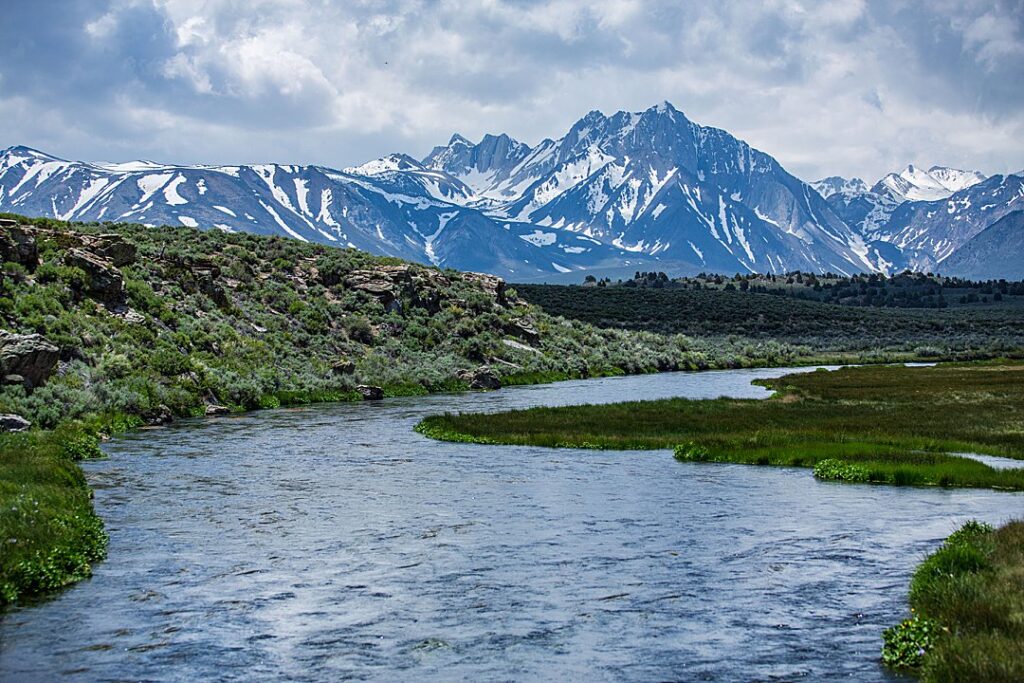
Photo Courtesy: Mammoth Lakes Tourism
Wildflowers in Spring and Summer
In spring and summer, Eastern Sierra dresses up in vibrant hues. Wildflowers bloom en masse across fields and valleys, creating natural carpets that stretch as far as your eyes can see.
This seasonal spectacle makes for stunning photography opportunities – just ask any landscape photographer who has had the pleasure. Fields dotted with blue lupines, orange poppies, pink monkey flowers…it’s an all-you-can-click buffet for photographers.
Spring Wildflower Photography Spots to Explore:
- Sierra Meadows: These expansive fields not only showcase a beautiful assortment of wildflowers but also offer panoramic views of the surrounding mountains, enhancing the visual drama.
- Rock Creek Canyon: This spot boasts a diverse range of wildflowers, and its flowing streams add a dynamic element to any photograph.
- Little Lakes Valley: An easy-to-access region with a series of lakes reflecting the blooming surroundings, making it a double treat for photographers.
Planning and Packing Tips:
- Anticipate varying temperatures. While days can get warm, evenings are often cool. Layered clothing is essential.
- A macro lens is a worthwhile addition to your gear, allowing you to capture intricate details of the wildflowers.
- Bring a lightweight, portable stool or mat, as you may find yourself waiting or needing to get low for the perfect shot.
Fall Foliage in Eastern Sierra
If spring is about fresh beginnings, then fall speaks volumes on endings- but not without putting on one helluva show first. As we move into autumn, Eastern Sierra starts its magical transformation into a vibrant display of fall colors.
The color change begins at higher elevations around mid-September due to cooler temperatures. The quaking aspen groves are particularly scenic during late September or early October when they turn brilliant shades of yellow-orange-red before finally shedding their leaves completely by November end.
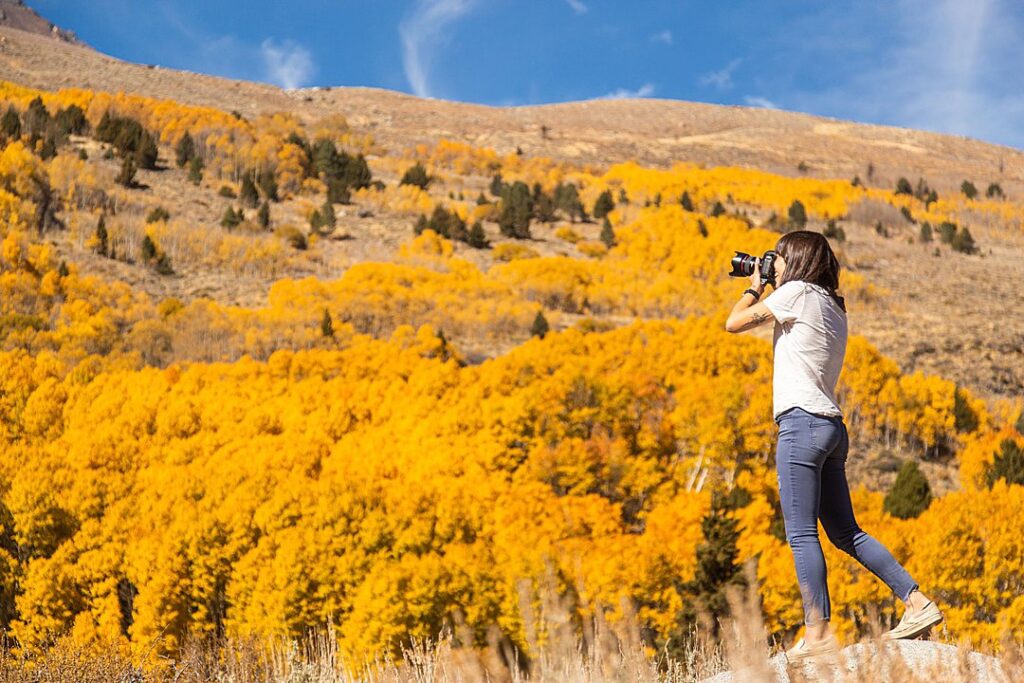
Photo Courtesy: Mammoth Lakes Tourism
Fall Color Photography Spots to Explore:
- June Lake Loop: Already highlighted for its pristine lakes, in fall, it turns into a wonderland of color with its surrounding aspen trees.
- Bishop Creek Canyon: Nestled between mountain peaks, this area’s dense concentration of aspens guarantees a breathtaking display of gold and red.
- Lundy Canyon: Featuring waterfalls, beaver ponds, and a spectacular array of fall colors, it’s a spot that offers diverse composition opportunities for every photographer.
Planning and Packing Tips:
- Days are cooler, and there’s a potential for early snowfall. Warm clothing and waterproof gear are a must.
- A polarizing filter can help enhance the vibrancy of the foliage against clear blue skies.
- Carry extra batteries. The colder weather can drain them faster than usual.
Searching for the Light: Customizing Your Photography Vacation
While you can find plenty of vistas right in and just outside of town, getting out into the mountains can truly elevate your photography. For inspiration and to plan your personal summit series, we recommend checking out the book Sierra Summits: A Guide to 50 Peak Experiences in California’s Range of Light. This hiking guide is perfect for planning a perfect vista-hunting photography trip.
The book is a collection of some of the most stunning viewpoints across the Eastern Sierra, inviting hikers to pause and breathe in fresh air while appreciating their surroundings. Each location provides lots of vistas and exceptional panoramic vistas that will have your social fans or friends back home oohing and ahhing over your trip.
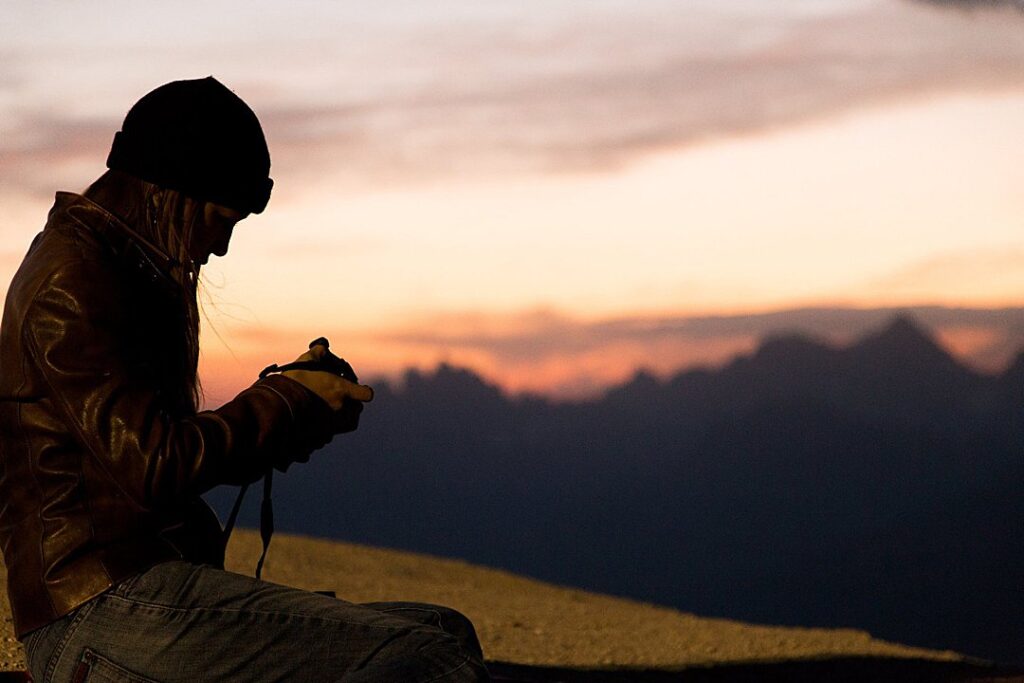
Photo Courtesy: Mammoth Lakes Tourism
Planning Your Trip to Eastern Sierra
Packing for a trip can be like solving a puzzle, especially when the destination is as diverse and captivating as the Eastern Sierra. But don’t worry. We’ve got you covered with some essential tips on weather conditions, packing essentials, and getting a head start on your road trip planning.
Packing Must-haves for Any Photography Adventure
We all know that trips become more memorable when we’re comfortable throughout our journey. So what should one pack while heading on a mountain photography adventure? Here are three things must-haves to consider:
- A good pair of hiking boots because there are so many hiking trails waiting to be explored.
- A warm jacket because the weather can turn chilly, especially in the evenings and early mornings.
- Your favorite camera gear. You dont have to bring all of your camera gear, just the gear you use the most and are familiar with. A shy bald eagle or the perfect pink sunset can be fleeting and you want to make sure you can set up fast, rather than fumbling with new or unfamiliar gear. The Eastern Sierra offers countless photo ops that any shutterbug would regret missing out on.
Additional Packing Tips for Different Weather Conditions in Eastern Sierra
Understanding the weather in the mountains is essential for a comfortable and successful trip. The region’s high elevation results in cooler temperatures than most of California. However, it can still get pretty warm during the summer months.
The best time to visit largely depends on what activities you plan to do.
Photographers might want to catch Mono Lake at sunset, while hiking enthusiasts may prefer autumn trails where leaves change color spectacularly around areas like June Lake Loop or McGee Creek Canyon.
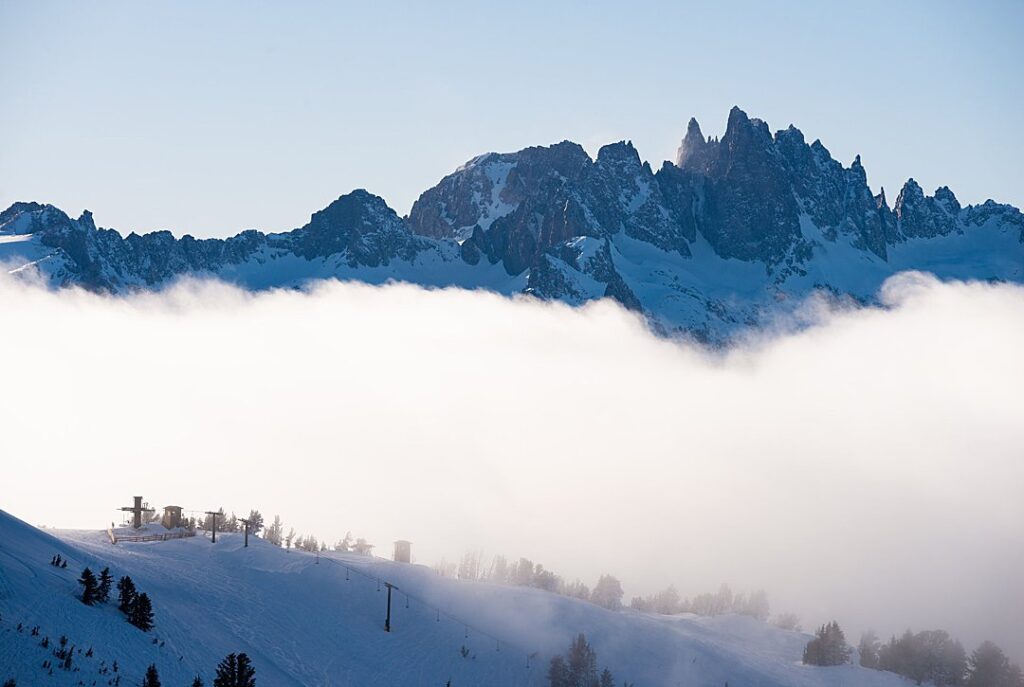
Photo Courtesy: Mammoth Lakes Tourism
Avoiding High-Altitude Sun: Pack Smart.
Summer days in Owens Valley can reach highs of 90°F (32°C), and the sun at altitude can be particularly intense.
To protect yourself from direct sunlight, pack lightweight clothing with long sleeves and hats that provide shade for your face.
Sunglasses are a must, helping to shield your eyes from harsh UV rays, especially in winter when sunlight bounces up from the snow and can cause snow blindness. Polarized sunglasses are especially useful if you’re scouting photo spots near lakes and rivers.
In addition, sunscreen is essential. Consider packing one that’s water-resistant, especially if expeditions on lakes are part of your itinerary.
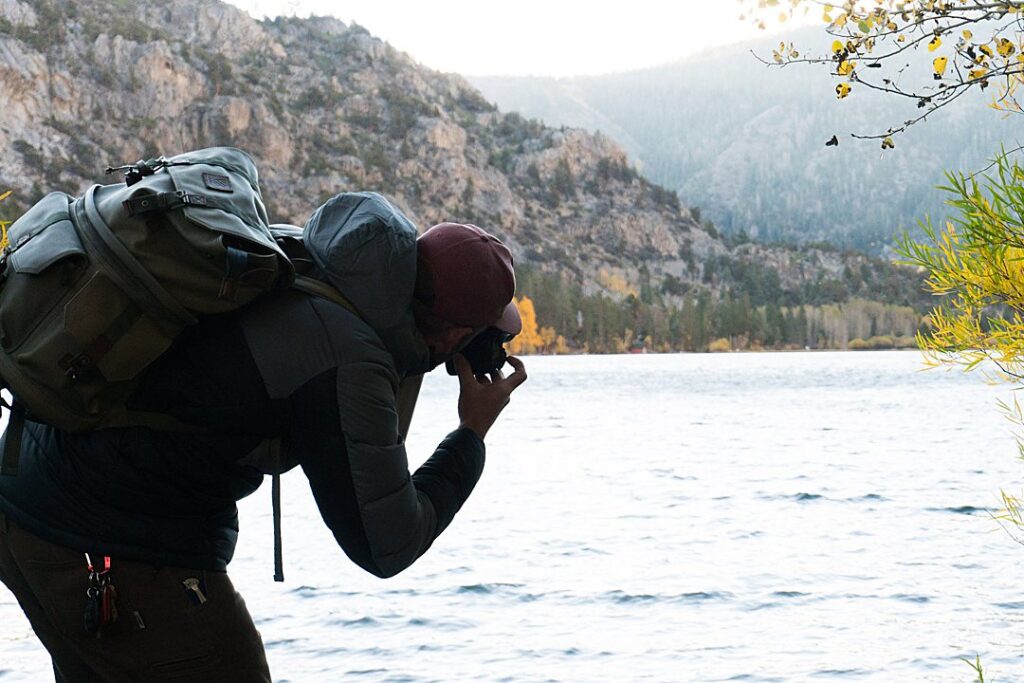
Photo Courtesy: Mammoth Lakes Tourism
Predictable Unpredictability: Layer Up.
The weather can be unpredictable in Mammoth Lakes’ mountain climate – particularly as seasons transition between fall color periods into winter snows in the high country around The Mammoth Lakes Basin.
This unpredictability makes layering key. Start with moisture-wicking base layers that keep sweat away from the skin. Middle layers like fleece jackets offer extra warmth and insulation as they trap heat close to body as the temperature drops post-sunset over the Sierra Nevada.
An outer shell will protect you from the elements. Waterproof and windproof jackets are essential, especially when exploring the stunning landscapes around Minaret Vista and trails leading into the backcountry from Horseshow Lake and Coldwater Trailheads.
The Essential Extras: Water bottles
Don’t forget to bring a few water bottles for hydration. Bringing lots of H2O is critical when you’re vista hunting on extended hikes. The thin air and brisk wind can dehydrate you, even in cooler temps.
Essential Gear for Photography Near Mammoth Lakes.
While the best gear to bring is gear you; ‘re familiar with, we have a few recommendations that will surely elevate your nature photography and ensure the images you capture will truly capture the sublime and fleeting moments in the mountains.
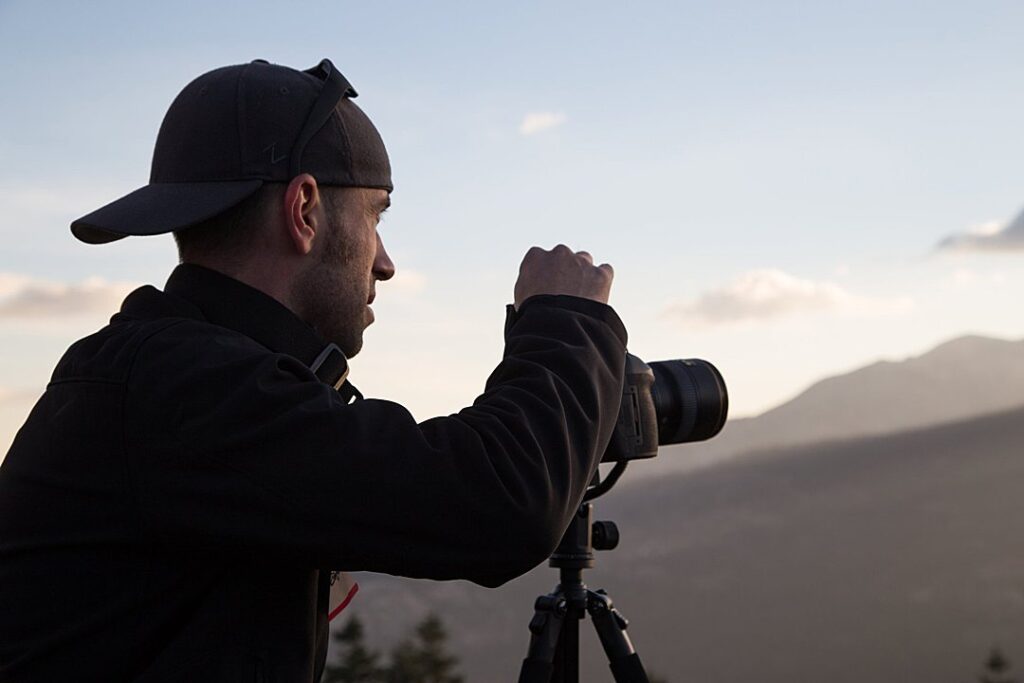
Photo Courtesy: Mammoth Lakes Tourism
Mountain Photography Must-haves
For those aiming to take stunning shots near Mammoth Lakes, there are certain tools that can make a substantial difference.
- A Tripod is indispensable for ensuring stability, especially when taking long exposure shots to capture the majestic movement of clouds or the glimmer of stars. If you left the tripod at home, consider finding a stable rock or surface to rest your camera on, but remember, the steadier the base, the clearer the shot.
- Polarized lens filters are crucial in reducing glare from reflective surfaces, ensuring that the lakes and snowy peaks in your photos pop with clarity and color. An alternative to using a special lens filter is using a quality pair of polarized sunglasses. Placing one of your sunglasses in front of the camera lens can work as a makeshift solution, although results may vary.
- Golden and Blue Light Apps Before you head out, consider downloading an app like “Golden Hour” (available on the App Store or Google Play). These apps will tell you exactly when the golden and blue hours will be at your location, ensuring your photos have that ethereal glow. If you don’t want to rely on an app, simply aim to shoot during the early morning or late evening when the light is naturally softer.
- An Intervalometer For those passionate about capturing the mesmerizing movements of the night sky, an Intervalometer is invaluable. This device allows you to take multiple timed shots, perfect for creating star trail images or time-lapse videos of the transitioning night sky. If you’re using a camera with built-in interval shooting features, you might skip this, but a dedicated device often offers more flexibility and precision
- Extra batteries and chargers. Lastly, when out in the cold mountain environment, batteries tend to drain faster. Carrying extra batteries and chargers ensures you don’t miss that perfect shot. If buying extras isn’t an option, try to keep your existing batteries warm. You can buy inexpensive hand warmers for your camera bad, or just keep your gear inside your jacket and close to your body, when you; ‘re not shooting to prolong battery life in the cold.
Extra items for wildlife photography
Wildlife abounds near Mammoth Lakes. While spotting wildlife is a common occurrence, capturing them on camera proves to be more difficult. A few additional items might be of immense help.
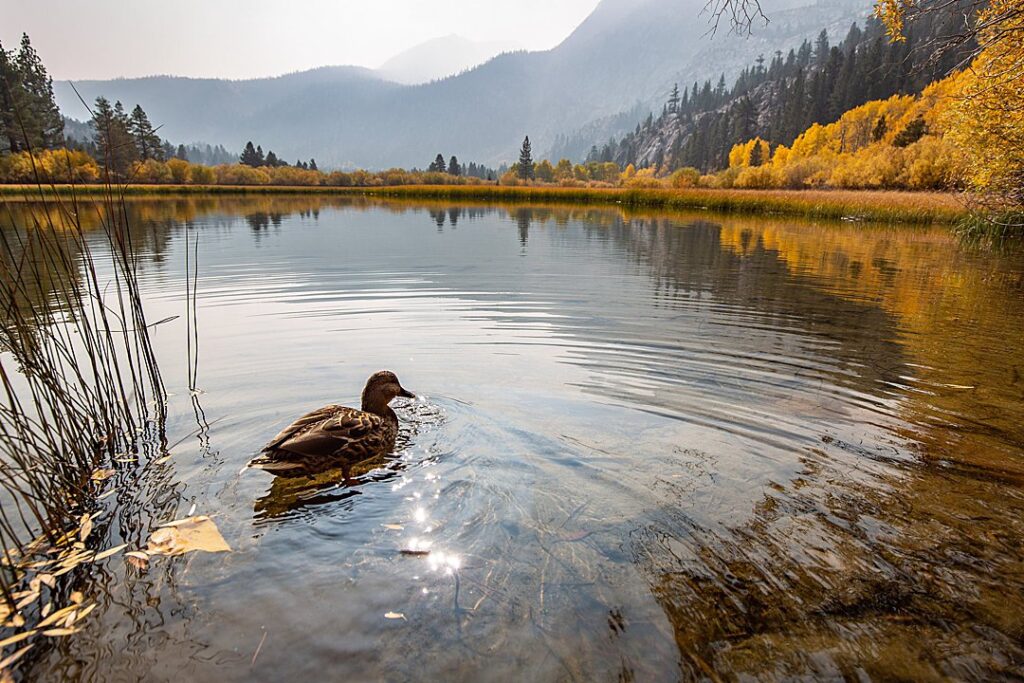
Photo Courtesy: Mammoth Lakes Tourism
- A comfortable chair will allow you to sit and wait for the perfect moment without tiring. They are lightweight, camp-style chairs that are lightweight and collapsable, making them easier to bring on longer hikes than a common beach or lawn chair. If you’re not keen on hauling a chair, any quiet, comfortable spot where you can sit and wait will do, like a soft patch of grass or a log.
- A zoom lens lets you get detailed shots of animals without getting too close and disturbing them. If bringing or purchasing a dedicated zoom lens is out of the question, try using the maximum optical zoom of your current lens and cropping the photo in post-production for a closer view. Keep in mind this may lead to a reduction in image quality.
- A fluid-head tripod. Lastly, for those passionate about capturing smooth panning shots or videos of animals in motion, a fluid-head tripod is a game-changer. This specialized tripod allows for smoother motion and better control. If bringing one isn’t feasible, practicing steady hand movements and using standard tripods with a pan feature can sometimes approximate the effect, though with lesser precision.
Outdoor Photography Tips in the Eastern Sierra
With its jaw-dropping landscapes and unending adventure possibilities, the Eastern Sierra region truly boasts an experience like no other It offers a chance to encapsulate nature’s grandeur and create a work of art with every shot. But different conditions call for different approaches to your photography. Below are some tips for special photography situations in the mountains.
Night Sky Photography in Eastern Sierra
The serenity of the Eastern Sierra region takes a captivating twist under the moonlight. Night landscape photography in this region is a blend of challenges and enchantment, mostly due to the lack of ambient light, which can make it tricky to capture fine details and balance exposure. The vast expanse of sky and elevation also mean clearer, star-filled nights that require a different approach to harness their potential.
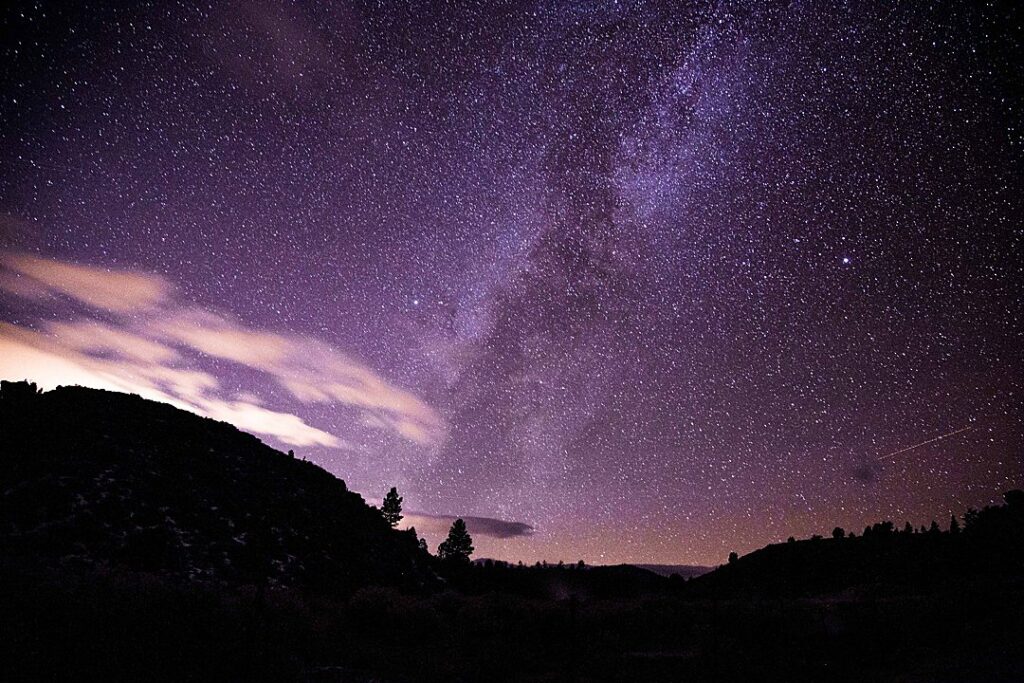
Photo Courtesy: Mammoth Lakes Tourism
- Master Manual Focus: Autofocus struggles in the dark. Use your camera’s manual focus and magnify the viewfinder display to ensure the stars or distant lights are pin-sharp.
- Use Long Exposures: A shutter speed of around 15-30 seconds will allow you to capture stars as points of light. If you aim to capture star trails, even longer exposures or stacking multiple images can do the trick.
- Keep an Eye on the ISO: Higher ISO settings can bring out more details in the dark, but also introduce noise. Find a balance that works for your camera and the available light.
Life in a Snow Globe: Winter Landscape Photography Tips
The snowy mantle that adorns the Eastern Sierra in winter transforms the region into a winter wonderland, but with this beauty comes unique challenges. Snow can act as a giant reflector, sometimes leading to overexposed shots. The cold can also affect equipment performance, and the sheer brightness can throw off your camera’s metering.
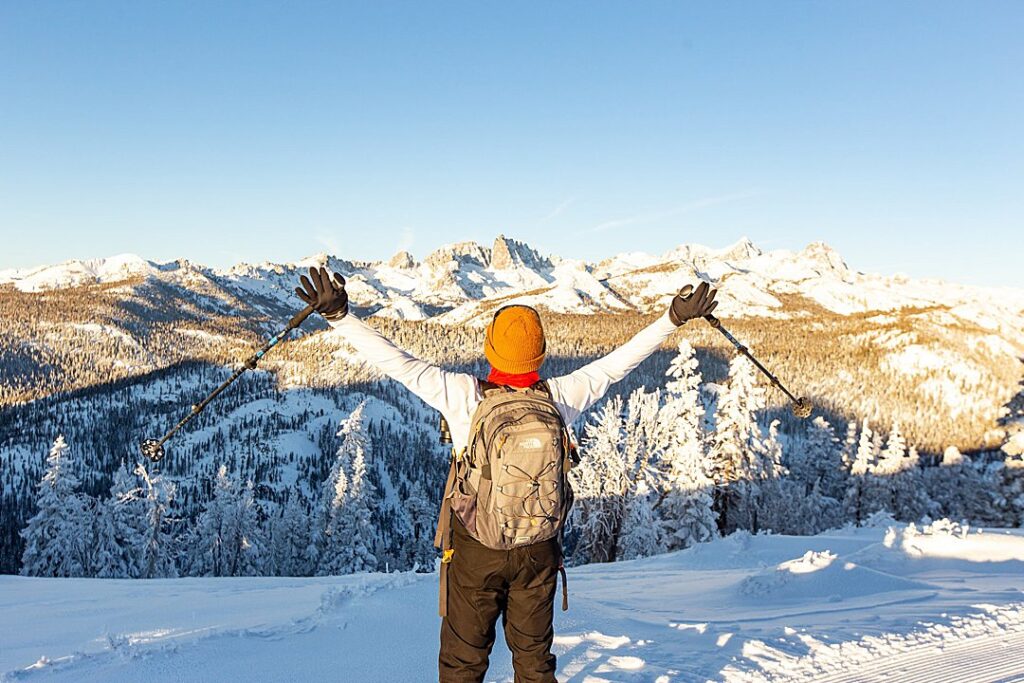
Photo Courtesy: Mammoth Lakes Tourism
- Expose for the Snow: Snow is tricky because it can fool your camera’s metering system. If your snow looks gray, try overexposing slightly to keep it bright white.
- Protect Your Equipment: Cold can drain batteries quickly, and moisture can be a menace. Keep extra batteries warm in your pocket, and consider a weather-sealed bag or case for your gear.
- Wear Polarized Sunglasses: This not only protects your eyes from the glaring snow but can also help you judge the scene’s contrast better when framing your shot.
A World of Water: Photography Tips for Shooting Bodies of Water
Capturing the pristine lakes and rivers of the Eastern Sierra region can be immensely rewarding, yet challenging. Water, with its reflective nature, can either enhance your image or become a distracting element. Dynamic lighting conditions and moving water also demand a different set of skills to render them effectively.
- Use Polarizing Filters: These can reduce reflections on the water surface, making it transparent, and also enhance the colors of the sky and foliage.
- Play with Shutter Speed: For silky-smooth water effects, use a slower shutter speed. If you want to freeze the motion of splashes or waves, opt for a faster speed.
- Consider Composition: Remember the rule of thirds and use the water as a leading line or foreground interest. Positioning the horizon off-center can add balance and intrigue to your frame.
More Photographic Gems of the Eastern Sierra
If you’re looking to find beauty beyond the beaten path, then let’s take a journey through some lesser-known locations in Eastern Sierra. You’ll discover stunning views that will race your heart and offer endless photo opportunities.
North of Mammoth Lakes
Beyond the renowned vistas of Mammoth Lakes lies a region equally rich in natural splendor and less trodden paths. Heading north, you’ll find yourself in a realm where the landscapes evolve, offering an eclectic mix of serene lakes, dense forests, and striking mountain backdrops. This area boasts a quiet charm that beckons photographers and nature enthusiasts alike. Here, one can truly embrace the wilderness, capture untouched beauty, and find solitude amidst nature’s grandeur.
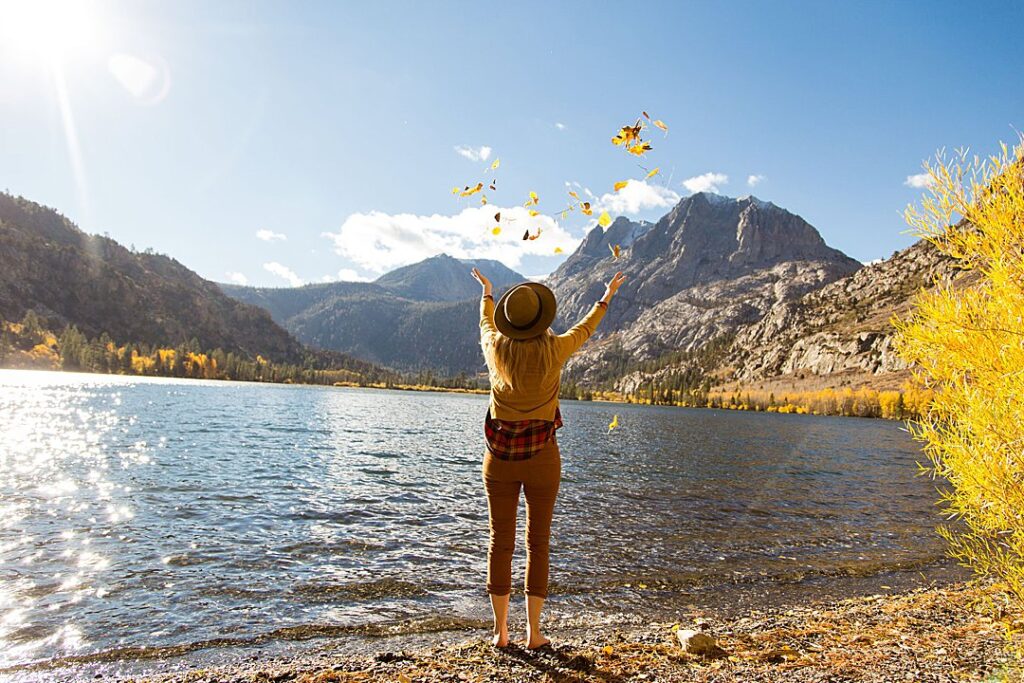
Photo Courtesy: Mammoth Lakes Tourism
A Journey Through June Lake Loop
It’s easy to think you have to head high up into the backcountry to get great photos, but stunning vistas are all along the roadside on the June Lake Loop, where jagged peaks form a dramatic backdrop for several, easy-to-access serene lakes: June Lake, Gull Lake, Silver Lake, and Grant Lake.
For a scenic hike with truly unique photographic opportunities, hike up Parker Bench Trail for historic arbor glyphs among expansive aspen groves, mountain streams, and panoramic mountain vistas at Parket Lake.
Fun fact: Visit Mammoth chose Silver Lake for one of its fall InstaMeets. The Aspen grove lining this serene lake made it a favorite among attendees looking to add fall color to their portfolios.
Fine Art Photography in Mono Basin
Mono Basin, with its unique geological formations and vast, untouched landscapes, is a haven for fine art photographers. This region isn’t just about capturing what’s in front of you; it’s about interpreting it and presenting it in a way that evokes emotion and tells a story. Here, the landscapes seem almost surreal, with tufa towers rising from the land and the ever-changing colors of the skies painting the basin in shades of gold, crimson, and lavender.
When capturing the basin, consider adopting a minimalist approach. The simplicity of the land, dotted with occasional brush, provides the perfect setting for evocative compositions. The textures of the salt flats, juxtaposed against the smooth surfaces of the water bodies, can lead to striking contrasts in monochromatic shots. Experiment with longer exposures, perhaps blurring the movement of clouds against the static, timeless terrain of the basin.
Mono Basin also has its share of wildlife. From birds taking flight against the backdrop of the setting sun to the silhouettes of coyotes on a dune ridge, integrating these elements can add a dynamic touch to your fine art compositions. Always remember, in fine art photography, it’s as much about what you choose to exclude from the frame as what you include.
Moonscape at Mono: Exploring Mono Lake:
Mono Lake, often referred to as California’s “Dead Sea,” offers a surreal, almost otherworldly photographic experience. Its alkaline waters and the iconic tufa towers that rise majestically from its depths give it an appearance reminiscent of a lunar landscape, earning it the nickname “Moonscape.”
Venturing to the lake during the early dawn or late dusk can be especially rewarding. The soft light bathes the tufa formations in a gentle glow, and the play of shadows adds depth and drama to the scene. The often still waters of the lake provide an opportunity for mirror-like reflections, doubling the visual impact of the tufa towers and the surrounding Sierra Nevada mountains.
For those wanting to capture the true essence of this “Moonscape,” consider shooting during a full moon night. The moonlight, reflecting off the lake’s surface and illuminating the tufa towers, creates an ethereal, dreamy setting. You’d be forgiven for thinking you’ve stepped onto another planet. Don’t forget to bring a sturdy tripod and use longer exposures to capture the delicate light and the vastness of the starry night sky. Mono Lake, with its unique geology and mystical ambiance, promises a photographic journey that’s out of this world.
Embark on an adventure through the breathtaking landscapes of the Eastern Sierra. Each location offers unique photo spots and a sense of place that is hard to match anywhere else.
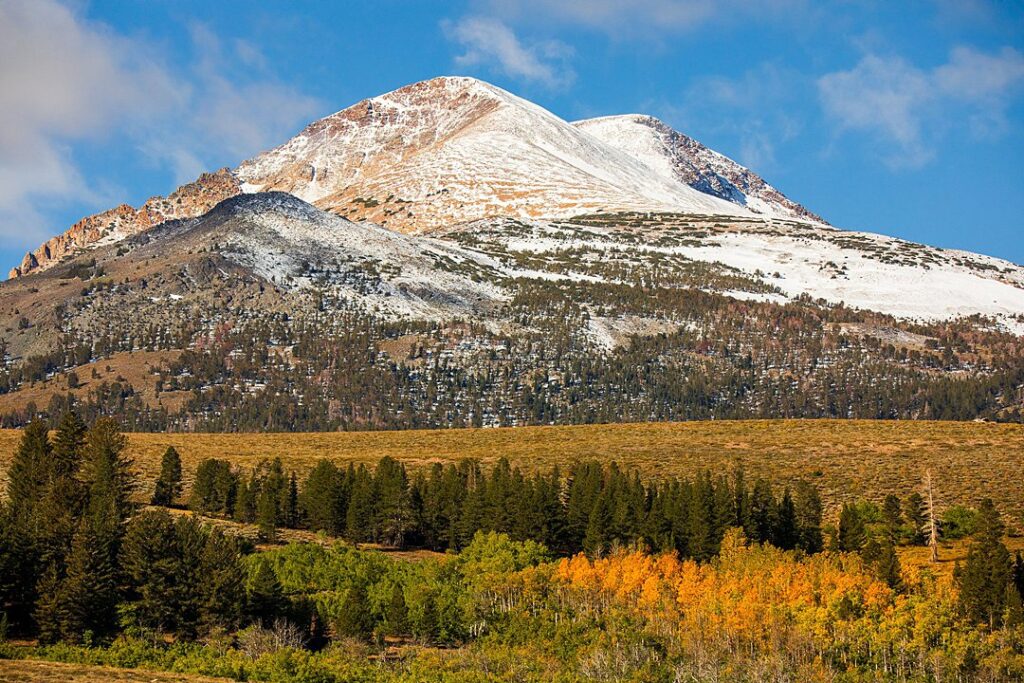
Photo Courtesy: Mammoth Lakes Tourism
Mono Lake Vista off of Conway Summit
Mono Lake Vista off Conway Summit, with its surreal tufa towers, presents captivating scenery unlike any other. Its jagged peaks kiss the sky, while Mono Lake glistens below – it’s not just a good spot, but an exceptional one for photographers.
The sunset at Mono lake paints vivid colors across the landscape creating enchanting views every evening. The allure doesn’t end here though; venture around and you’ll find surprises like South Tufa – fascinating limestone formations adding another layer to this picturesque setting.
Virginia Lakes: A Picture-Perfect Escape
Nestled amidst the towering peaks of the Eastern Sierra, Virginia Lakes offers a serene escape that is every photographer’s dream. The chain of shimmering alpine lakes, surrounded by lush meadows and rugged mountain terrain, is a visual treat, presenting a multitude of photographic opportunities throughout the year.
In the warmer months, the azure waters reflect the surrounding peaks, creating symmetric compositions that are both dramatic and serene.
In the colder months, the snow-capped surroundings and icy waters offer a stark, monochrome palette that’s equally enchanting. Always ensure you’re well-equipped for the colder temperatures, and remember that the ethereal beauty of Virginia Lakes, in any season, is well worth the journey.
Lundy Canyon: An Unforgettable Adventure
Lundy Canyon, located just north of Mammoth Lakes, is a testament to the raw, untouched beauty of the Eastern Sierra region. This rugged landscape, with its cascading waterfalls, vibrant autumn colors, and diverse wildlife, presents an exhilarating backdrop for both adventure and photography.
Spring and early summer are ideal times to visit, as this is when the waterfalls are at their most dramatic, fed by the melting snow from the mountains above. The roar of the water and the mist in the air add an atmospheric quality to your shots.
For those seeking a blend of adventure and art, Lundy Canyon is a destination that should not be overlooked. Whether you’re capturing the vibrant hues of fall, the dynamic flow of waterfalls, or the serene beauty of the ponds, this location promises images that will stay etched in memory long after the adventure is over.
South of Mammoth Lakes
Venture south of Mammoth Lakes, and you’ll be greeted by a mosaic of diverse landscapes that beckon the adventurous spirit. This southern stretch, while close to the bustling heart of Mammoth, feels like a world away, characterized by its secluded spots, majestic peaks, and serene water bodies. Each location, from the tranquility of Aspendell to the imposing stature of Mount Morrison, is a testament to nature’s artistry. Whether it’s the gentle flow of Owens River or the picturesque settings of McGhee Creek, the southern expanse offers a plethora of visual treats waiting to be framed.
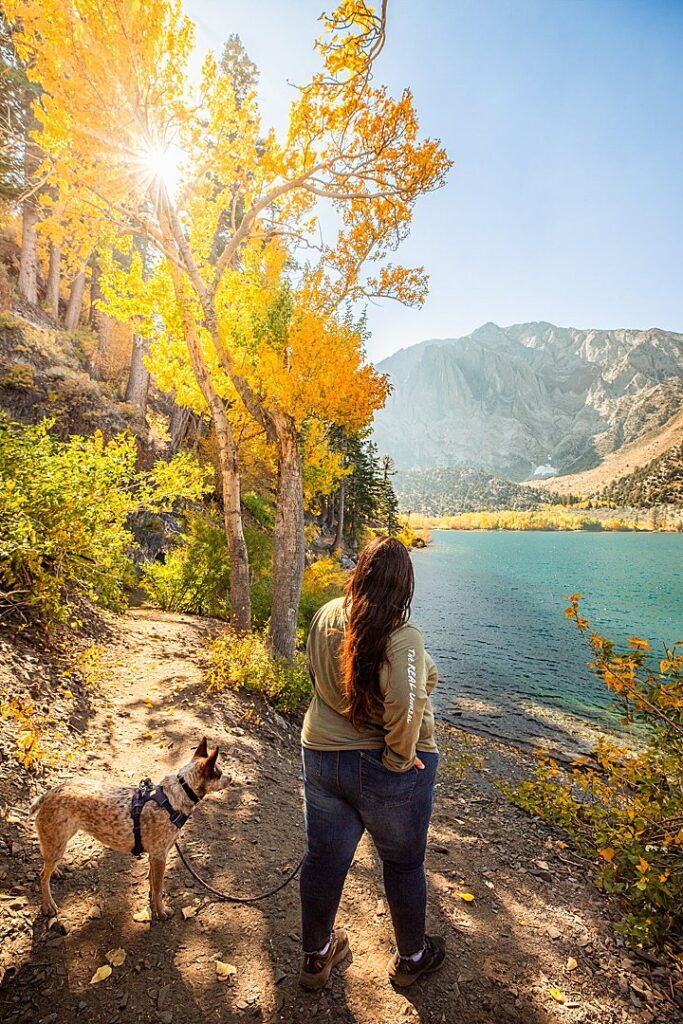
Photo Courtesy: Mammoth Lakes Tourism
Magnificent Mount Morrison
Towering over the Eastern Sierra landscape, Mount Morrison presents itself as a photographic marvel and a testament to nature’s raw sculpting powers. Its distinct, rugged ridgelines, juxtaposed against the often crystal-clear blue sky, provide photographers with contrasts that are hard to find elsewhere. Part of the esteemed Sierra Nevada range, this mountain is not just a towering peak but a canvas of geological history, presenting layers upon layers of rock formations.
But it’s not just the mountain’s stature that captures the heart. The area surrounding Mount Morrison offers dynamic terrains, from vast meadows that change hue with the seasons to small streams reflecting the mountain’s grandeur. Sunrise and sunset photographers, in particular, will appreciate how the mountain’s faces play with light and shadow, casting an array of colors and creating a symphony of tones that make every shot unique.
Remember to venture towards the Convict Lake area. Located at the base of Mount Morrison, this lake offers mirrored reflections of the mountain, especially during the calm mornings, turning your photographs into symmetric masterpieces. The trail around the lake also offers varying perspectives, ensuring you get a comprehensive portfolio of this magnificent peak. And if you’re lucky, you might even catch glimpses of the local wildlife, adding life and movement to your landscape shots.
Fun Fact: VisitMammoth has also hosted InstaMeets at Convict Lake, and photographers found plenty of points of interest to fill an entire day of hiking and taking pictures.
The Art of Abstract Photography at Owens River
The Owens River, with its meandering flow through the Eastern Sierra, provides more than just picturesque landscapes; it’s a canvas for abstract photography. While the vast landscapes of the region demand wide-angle captures, Owens River invites you to look closer, to find beauty in details, and to reimagine the natural world in abstract forms.
At first glance, the river might seem like a calm flow of water set against a mountainous backdrop. However, for the keen-eyed photographer, it’s a plethora of patterns and textures. The ripples on the water surface, shaped by the gentle breeze, create ever-changing designs that play with light. The reflections of the surrounding foliage or the scattered clouds overhead offer a distorted, dreamy rendition of reality, perfect for abstract shots.
Delve deeper by focusing on the interplay between the submerged river stones and the refracted light. The dance of shadows and highlights, the swirls of sediments, or the trails left by small aquatic creatures can be captured to create mesmerizing abstract compositions.
Consider using a polarizing filter to cut through the river’s glare, revealing its submerged world in richer detail. And don’t forget to experiment with shutter speeds; a slightly longer exposure can turn the river’s flow into a silky-smooth texture, while a fast shutter can freeze the chaotic splash of a jumping fish or the ripples from a dropped pebble. Owens River, in its subtle beauty, challenges photographers to look beyond the obvious, pushing the boundaries of perception and artistic expression.
McGhee Creek: The Serene Trailside Canvas
Nestled in the southern landscapes near Mammoth Lakes, McGhee Creek is a lesser-known delight that offers photographers a peaceful respite from more frequented spots. Winding its way through the Eastern Sierra, the creek is bordered by lush meadows and set against a backdrop of towering peaks, making it an idyllic setting for landscape photography.
One of the highlights of McGhee Creek is its trail – a path that promises both serenity and scenic vistas. As you traverse the trail, you’ll encounter a myriad of photo opportunities, from close-ups of the creek’s babbling waters to panoramic shots of the encompassing mountain range.
Aspendell: The Autumnal Wonderland
Tucked away in the Bishop Creek Canyon, Aspendell is a hidden gem in the Eastern Sierra region. Renowned for its dense groves of aspen trees, it becomes a visual spectacle in the fall when the leaves transform into a riot of golds, oranges, and reds. Aspendell’s scenic beauty combined with its tranquillity, makes it a top choice for photographers seeking to capture the essence of Eastern Sierra’s autumn.
During the peak of fall, the rustling of the aspen leaves creates a symphony, complementing the serene beauty surrounding you. How the sun filters through the golden canopy, casting dappled light onto the forest floor, presents opportunities for some truly ethereal compositions.
Aspendell’s charm isn’t just limited to its autumnal glory. The community itself, with its quaint cabins and friendly locals, adds a touch of warmth to the experience. Whether you’re there for the colors, the landscapes, or simply the serene ambiance, Aspendell promises a photography session that’s both rewarding and rejuvenating.
Your Next Photography Adventure Starts Here
Embarking on a journey of Photography in the Eastern Sierra is an adventure like no other. The region offers not just views but stories – those etched into granite boulders by time.
The seasonal colors add another layer of charm! Wildflowers bloom bright against granite boulders during spring and summer; vibrant fall foliage sets landscapes ablaze with color.
But remember: it’s not only about taking pictures. It’s capturing memories amidst these natural wonders, making moments stand still under your lens!
And all are easily accessible from Sierra Meadows Ranch. Book your photography adventure with us.
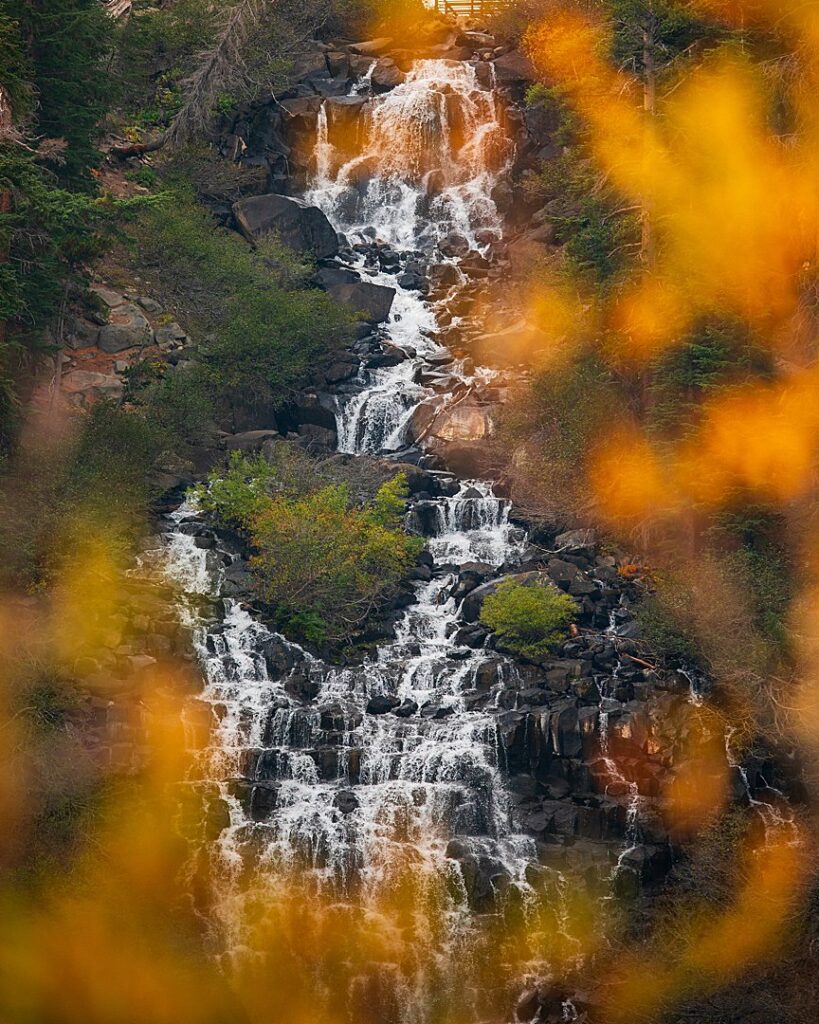
Photo Courtesy: Mammoth Lakes Tourism
FAQs in Relation to Photography in the Eastern Sierra
What is the best time of year for photography in the Eastern Sierra?
The Eastern Sierra offers unique photographic opportunities all year round. Spring and summer bring vibrant wildflowers and clear skies. Fall is renowned for its stunning foliage, especially in areas with aspen trees. Winter, while chilly, presents a serene snow-covered landscape. Your preference will depend on the type of scenes and colors you wish to capture.
Are there specific regulations or permits required for photography in the region?
For casual photography meant for personal use, generally no permits are required. However, if you’re planning commercial shoots, drone photography, or have a larger crew and equipment, you might need permits, especially in national parks or protected areas. It’s always best to check with local authorities or the specific location you’re heading to.
How accessible are the prime photography spots from Mammoth Lakes?
Many prime photography locations, like the June Lake Loop, and Sierra Meadows, are easily accessible by car from Mammoth Lakes. Some might require a short hike, but the region is known for its picturesque landscapes even right off the roadside.
Do I need any specialized gear for photography in this region?
While standard photography equipment will serve you well, considering the diverse range of scenes from vast landscapes to macro wildflower shots, various lenses could be beneficial. A tripod is essential for stable shots, especially during dawn, dusk, or night photography. Polarized lenses or filters can help capture the vibrancy of skies and water bodies. If you plan to hike, ensure your gear is lightweight and weatherproof.
Are there local workshops or photography tours I can join in Mammoth Lakes?
Yes, Mammoth Lakes and the surrounding Eastern Sierra region often host photography workshops and tours, especially during peak seasons like fall. Local photographers and tour operators provide these sessions, helping attendees find the best spots, understand the right settings, and improve their photography skills. Check with VisitMammoth.com or online platforms for upcoming events.
Remember, while the Eastern Sierra offers breathtaking scenes, always be mindful of the environment, respect local regulations, and practice “Leave No Trace” principles. Happy shooting!
